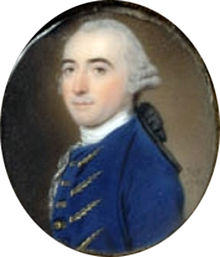Valentine Morris
| Valentine Morris | |
|---|---|

Valentine Morris, c.1765
|
|
| Born | 27 October 1727 Antigua, West Indies |
| Died | 26 August 1789 (aged 61) Bloomsbury, London |
| Nationality | British |
| Occupation | Landowner, politician |
| Known for | Development of Piercefield Park Governor of St. Vincent |
Valentine Morris (27 October 1727 – 26 August 1789) was a British landowner born in Antigua in the West Indies, who was responsible for developing the picturesque woodland walks at Piercefield in the Wye valley and later became Governor of St. Vincent.
He was the son of Colonel Valentine Morris (c 1678-1743), a sugar plantation owner and merchant who claimed descent from the Walter family of Monmouthshire and who, in 1740, bought Piercefield House near Chepstow.
On his father's death, the younger Valentine Morris, who was then attending school in London, inherited Piercefield. In 1748 he married Mary Mordaunt, a niece of the third Earl of Peterborough, and began living at Piercefield with his family in 1753. Morris added to the magnificent splendour of the estate and its setting, by landscaping the parkland, with the help of Richard Owen Cambridge, in the fashionable style of Capability Brown. At a time when tourism in the Wye valley was starting to become popular, Piercefield was developed into a park of national reputation, as one of the earliest examples of Picturesque landscaping. Morris laid out walks through the woodland and included a grotto, druid’s temple, bathing house and giant’s cave. He also developed viewpoints along the clifftop above the River Wye, and opened the park up to visitors. One of the many tourists to marvel at this view was the poet Coleridge, who wrote: "Oh what a godly scene....The whole world seemed imaged in its vast circumference".
Morris was strongly in favour of road improvement, and promoted the first Turnpike Bill in Monmouthshire, enacted in 1755. He gave evidence to the House of Commons that there were no roads in Monmouthshire and, when asked how people travelled, replied "We travel in ditches". As trustee of several turnpike trusts, he was responsible for maintaining and improving the roads from Chepstow to Raglan, Woolaston, and Beachley, often against the wishes of the local gentry who owned the land through which improvements were made. He was responsible for ensuring the building of over 300 miles of turnpike roads in Monmouthshire and Gloucestershire during the 1760s. As a magistrate, he also imposed standardised weights and measures in trading, for the first time in the area .
...
Wikipedia
